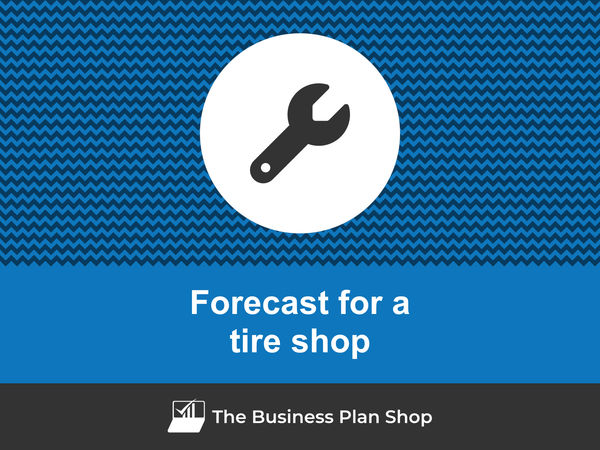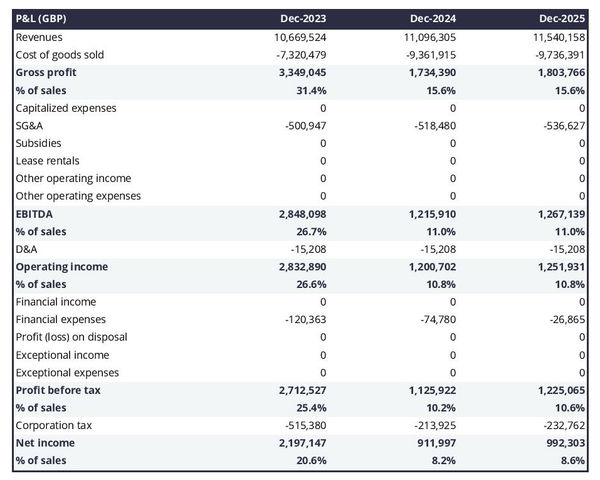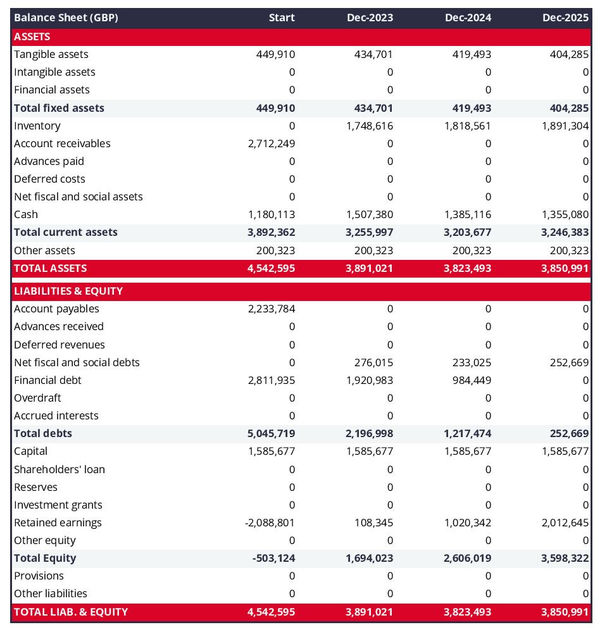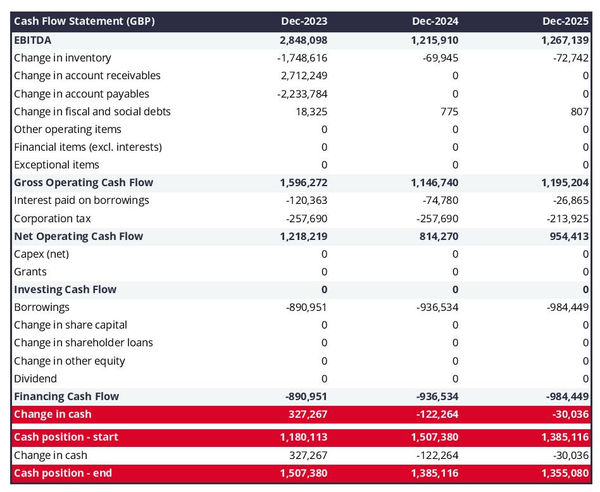How to create a financial forecast for a tire shop?

If you are serious about keeping visibility on your future cash flows, then you need to build and maintain a financial forecast for your tire shop.
Putting together a tire shop financial forecast may sound complex, but don’t worry, with the right tool, it’s easier than it looks, and The Business Plan Shop is here to guide you.
In this practical guide, we'll cover everything you need to know about building financial projections for your tire shop.
We will start by looking at why they are key, what information is needed, what a forecast looks like once completed, and what solutions you can use to create yours.
Let's dive in!
Why create and maintain a financial forecast for a tire shop?
In order to prosper, your business needs to have visibility on what lies ahead and the right financial resources to grow. This is where having a financial forecast for your tire shop becomes handy.
Creating a tire shop financial forecast forces you to take stock of where your business stands and where you want it to go.
Once you have clarity on the destination, you will need to draw up a plan to get there and assess what it means in terms of future profitability and cash flows for your tire shop.
Having this clear plan in place will give you the confidence needed to move forward with your business’s development.
Having an up-to-date financial forecast for a tire shop is also useful if your trading environment worsens, as the forecast enables you to adjust to your new market conditions and anticipate any potential cash shortfall.
Finally, your tire shop's financial projections will also help you secure financing, as banks and investors alike will want to see accurate projections before agreeing to finance your business.
Need a solid financial forecast?
The Business Plan Shop does the maths for you. Simply enter your revenues, costs and investments. Click save and our online tool builds a three-way forecast for you instantly.

What information is used as input to build a tire shop financial forecast?
A tire shop's financial forecast is only as good as the inputs used to build it.
If you are creating (or updating) the forecast of an existing tire shop, then you mostly need your accounting information, key historical operating non-financial data, and your team’s input on what to expect for the coming years.
If you are building financial projections for a tire shop startup, you will need to have done your research and have a clear picture of your competitive environment and go-to-market strategy so that you can forecast sales accurately.
For a new venture, you will also need a precise list of the resources needed to keep the tire shop running on a day-to-day basis and a list of the equipment and expenditures required to start the business (more on that later).
Let's now take a closer look at the elements that make up your tire shop's financial forecast.
The sales forecast for a tire shop
The sales forecast, also called topline projection, is normally where you will start when building your tire shop financial forecast.
Creating a coherent sales projection boils down to estimating two key drivers:
- The average price
- The number of monthly transactions
To do this, you will need to rely on historical data (for an existing business), market research data (for both new and existing tire shops), and consider the elements below:
- Weather conditions: The average price of tires may be affected by seasonal changes in weather. In the winter, demand for winter tires may increase, leading to higher prices. Similarly, in the summer, more people may be looking to purchase all-season tires, driving prices up.
- Cost of raw materials: The cost of raw materials used in tire production, such as rubber and steel, can impact the average price of tires. If the cost of these materials increases, it may lead to higher prices for the end consumer.
- Competitor pricing: The pricing of tires by competitors in the local market can also affect your average price. If a competitor is offering lower prices, it may be necessary to adjust your prices in order to remain competitive.
- Customer demographics: The demographic of your customer base can also have an impact on the average price of tires. For example, if your shop is located in an affluent area, customers may be willing to pay higher prices for premium tires.
- Vehicle trends: The types of vehicles that are popular in your area can also affect the average price of tires. For instance, if there is an increase in the number of trucks and SUVs on the road, there may be a higher demand for larger and more expensive tires.
After the sales forecast comes the operating expenses budget, which we will now look into in more detail.
Need inspiration for your business plan?
The Business Plan Shop has dozens of business plan templates that you can use to get a clear idea of what a complete business plan looks like.

The operating expenses for a tire shop
The next step is to estimate the expenses needed to run your tire shop on a day-to-day basis.
These will vary based on the level of sales expected, and the location and size of your business.
But your tire shop's operating expenses should include the following items at a minimum:
- Staff costs: This includes salaries, wages, and benefits for all employees, such as mechanics, salespeople, and administrative staff.
- Rent/lease: This expense covers the cost of your tire shop's physical location, including utilities, maintenance, and property taxes.
- Inventory: As a tire shop, you need to constantly replenish your inventory of tires, tubes, and other products. This expense also includes the cost of shipping and handling.
- Marketing and advertising: To attract customers, you may need to invest in marketing strategies such as online ads, flyers, and promotions.
- Accountancy fees: You may hire an accountant to assist with tax preparation, bookkeeping, and financial planning.
- Insurance costs: This includes liability insurance, worker's compensation, and property insurance to protect your business and employees.
- Software licenses: To run your tire shop efficiently, you may need to purchase software for inventory management, accounting, and point of sale systems.
- Banking fees: Your tire shop may incur fees for processing credit and debit card payments, ATM withdrawals, and wire transfers.
- Vehicle expenses: If you offer mobile tire services, you may need to budget for fuel, maintenance, and insurance for your service vehicles.
- Utilities: This includes the cost of electricity, water, and gas for your tire shop.
- Professional development: To stay up-to-date with industry trends and techniques, you may need to attend conferences, workshops, and training programs.
- Repairs and maintenance: Your tire shop's equipment, such as tire changers and balancers, may require regular maintenance and occasional repairs.
- Office supplies: This includes items such as paper, pens, and printer ink for your tire shop's administrative tasks.
- Taxes and licenses: Your tire shop may be subject to sales tax, business license fees, and other taxes and fees depending on your location.
- Professional services: You may need to hire outside consultants, lawyers, or marketing agencies to help with specific projects or tasks.
This list is, of course, not exhaustive, and you'll have to adapt it according to your precise business model and size. A small tire shop might not have the same level of expenditure as a larger one, for example.
What investments are needed to start or grow a tire shop?
Your tire shop financial forecast will also need to include the capital expenditures (aka investments in plain English) and initial working capital items required for the creation or development of your business.
For a tire shop, these could include:
- Tire Changer: This is a crucial piece of equipment for a tire shop, as it allows you to quickly and efficiently change tires for your customers. There are various types of tire changers available, such as manual, semi-automatic, and fully automatic, so be sure to research and invest in one that best suits your needs.
- Wheel Balancer: Just like a tire changer, a wheel balancer is essential for a tire shop. It ensures that the wheels are properly balanced, preventing vibrations and uneven wear on tires. Similar to tire changers, there are different types of wheel balancers available, so choose one that is suitable for your shop's volume and budget.
- Alignment Machine: Another important piece of equipment for a tire shop is an alignment machine. This machine ensures that the wheels are aligned correctly, which not only improves the handling and performance of the vehicle but also increases the lifespan of the tires. There are different types of alignment machines available, such as 3D, 4-wheel, and laser, so choose one that meets your shop's needs.
- Tire Inventory: In order to provide a wide range of tire options for your customers, you will need to invest in a tire inventory. This includes purchasing tires from various manufacturers and keeping an adequate stock of popular sizes and brands. Having a diverse tire inventory can attract more customers and increase sales.
- Diagnostic Tools: Diagnostic tools are essential for identifying and fixing issues with tires, such as punctures, leaks, and tread wear. These tools include tire pressure gauges, tread depth gauges, and tire leak detectors. Having these tools on hand can save time and money for your shop, as well as provide efficient and accurate services for your customers.
Again, this list will need to be adjusted according to the size and ambitions of your tire shop.
Need a convincing business plan?
The Business Plan Shop makes it easy to create a financial forecast to assess the potential profitability of your projects, and write a business plan that’ll wow investors.

The financing plan of your tire shop
The next step in the creation of your financial forecast for your tire shop is to think about how you might finance your business.
You will have to assess how much capital will come from shareholders (equity) and how much can be secured through banks.
Bank loans will have to be modelled so that you can separate the interest expenses from the repayments of principal, and include all this data in your forecast.
Issuing share capital and obtaining a bank loan are two of the most common ways that entrepreneurs finance their businesses.
What tables compose the financial plan for a tire shop?
Now let's have a look at the main output tables of your tire shop's financial forecast.
The profit & loss forecast
The forecasted profit & loss statement will enable you to visualise your tire shop's expected growth and profitability over the next three to five years.

A financially viable P&L statement for a tire shop should normally show:
- Sales growing above inflation
- Stable or expanding (ideally) profit margins
- A net profit
This will of course depend on the stage of your business: a new venture might be loss-making until it reaches its breakeven point in year 2 or 3, for example.
The projected balance sheet
Your tire shop's projected balance sheet provides a snapshot of your business’s financial position at year-end.
It is composed of three types of elements: assets, liabilities and equity:
- Assets: represent what the business possesses including cash, equipment, and accounts receivable (money owed by clients).
- Liabilities: represent funds advanced to the business by lenders and other creditors. They include accounts payable (money owed to suppliers), taxes payable and loans from banks and financial institutions.
- Equity: is the combination of what has been invested by the business owners and the cumulative profits and losses generated by the business to date (which are called retained earnings). Equity is a proxy for the value of the owner's stake in the business.

The cash flow forecast
Your tire shop's cash flow forecast shows how much cash your business is expected to consume or generate in the years to come.

It is best practice to organise the cash flow forecast by nature to better explain where cash is used or generated by the tire shop:
- Operating cash flow: shows how much cash is generated by the operating activities
- Investing cash flow: shows how much will be invested in capital expenditure to maintain or expand the business
- Financing cash flow: shows if the business is raising new capital or repaying financiers (debt repayment, dividends)
Keeping an eye on (and regularly updating) your tire shop's cash flow forecast is key to ensuring that your business has sufficient liquidity to operate normally and to detect financing requirements as early as possible.
If you are trying to raise capital, you will normally be asked to provide a monthly cash flow forecast in your tire shop's financial plan - so that banks or investors can assess seasonal variation and ensure your business is appropriately capitalised.
Need a solid financial forecast?
The Business Plan Shop does the maths for you. Simply enter your revenues, costs and investments. Click save and our online tool builds a three-way forecast for you instantly.

Which tool should you use to create your tire shop's financial forecast?
Creating your tire shop's financial forecast may sound fairly daunting, but the good news is that there are several ways to go about it.
Using online financial forecasting software to build your tire shop's projections
The modern and easiest way is to use professional online financial forecasting software such as the one we offer at The Business Plan Shop.
There are several advantages to using specialised software:
- You can easily create your financial forecast by letting the software take care of the financial calculations for you without errors
- You have access to complete financial forecast templates
- You get a complete financial forecast ready to be sent to your bank or investors
- You can easily track your actual financial performance against your financial forecast, and recalibrate your forecast as the year goes by
- You can create scenarios to stress test your forecast's main assumptions
- You can easily update your forecast as time goes by to maintain visibility on future cash flows
- You have a friendly support team on standby to assist you when you are stuck
- It’s cost-efficient and much cheaper than using an accountant or consultant (see below)
If you are interested in this type of solution, you can try our forecasting software for free by signing up here.
Calling in a financial consultant or chartered accountant
Enlisting the help of a consultant or accountant is also a good way to obtain a professional tire shop financial forecast.
The downside of this solution is its cost. From experience, obtaining a simple financial forecast over three years (including a balance sheet, income statement, and cash flow statement) is likely to cost a minimum of £700 or $1,000.
The indicative cost above, is for a small business, and a forecast is done as a one-shot exercise. Using a consultant or accountant to track your actuals vs. forecast and to keep your financial projections up to date on a monthly or quarterly basis will cost a lot more.
If you opt for this solution, make sure your accountant has in-depth knowledge of your industry, so that they may challenge your figures and offer insights (as opposed to just taking your assumptions at face value to create the forecast).
Why not use a spreadsheet such as Excel or Google Sheets to build your tire shop's financial forecast?
Creating an accurate and error-free tire shop financial forecast with a spreadsheet is very technical and requires a deep knowledge of accounting and an understanding of financial modelling.
Very few business owners are financially savvy enough to be able to build a forecast themselves on Excel without making mistakes.
Lenders and investors know this, which is why forecasts created on Excel by the business owner are often frowned upon.
Having numbers one can trust is key when it comes to financial forecasting and to that end using software is much safer.
Using financial forecasting software is also faster than using a spreadsheet, and, with the rise of artificial intelligence, software is also becoming smarter at helping us analyse the numbers to make smarter decisions.
Finally, like everything with spreadsheets, tracking actuals vs. forecasts and keeping your projections up to date as the year progresses is manual, tedious, and error-prone. Whereas financial projection software like The Business Plan Shop is built for this.
Need a convincing business plan?
The Business Plan Shop makes it easy to create a financial forecast to assess the potential profitability of your projects, and write a business plan that’ll wow investors.

Use our financial projection templates for inspiration
The Business Plan Shop has dozens of financial forecast templates available.
Our examples contain a complete business plan with a financial forecast and a written presentation of the company, the team, the strategy, and the medium-term objectives.
Whether you are just starting out or already have your own tire shop, looking at our financial forecast template is a good way to:
- Understand what a complete business plan should look like
- Understand how you should model financial items for your tire shop

Takeaways
- A financial projection shows expected growth, profitability, and cash generation for your business over the next three to five years.
- Tracking actuals vs. forecast and keeping your financial forecast up-to-date is the only way to maintain visibility on future cash flows.
- Using financial forecasting software makes it easy to create and maintain up-to-date projections for your tire shop.
You have reached the end of our guide. We hope you now have a better understanding of how to create a financial forecast for a tire shop. Don't hesitate to contact our team if you have any questions or want to share your experience building forecasts!
Need inspiration for your business plan?
The Business Plan Shop has dozens of business plan templates that you can use to get a clear idea of what a complete business plan looks like.

Also on The Business Plan Shop
Know someone who runs or wants to start a tire shop? Share our financial projection guide with them!




